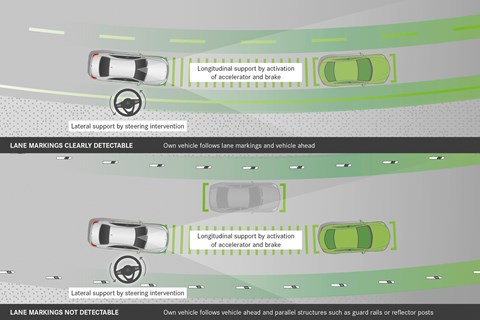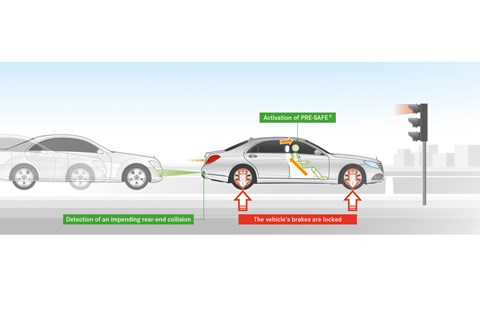► Mercedes ‘driving assistance plus package’
► Costs £1695, bundles semi-autonomous tech
► Lane keeping, brake assist, lane change, drive pilot
Although I’d ordinarily feel obliged to tell you just how good the new Mercedes-AMG E43 saloon is like to drive (it is), that’s not quite why we’re here today. A trip north on the M6 was a chance to see what AMG’s new entry-level brand was like to… not drive.
That’s because our E43 test car was optioned with the ‘driving assistance plus package’. It costs £1695, is available on other Mercedes, and contains a bundle of features that can be a little bamboozling. Basically, it boils down to this:
• Active blind spot and lane-keeping assist. Steers you back in your lane if you stray over solid white lines or over broken lines into the path of oncoming traffic. Also monitors traffic pulling up either side, steering you away from it if you try to cross into their lane.
• Active brake assist and evasive steering assist. Brakes if you’re not going to, and corrects steering inputs if you’re swerving around things and would otherwise lose control.
• Active lane change assist. Activate the indicator for at least two seconds and the car checks around itself, then autonomously changes lanes if all is clear.
• Drive pilot. The really important bit. This is the catch-all for cruise control that automatically adapts to traffic speed and speed limits, even coming to a complete stop.
You also get ‘Steering Pilot’ semi-autonomous steering so you can remove hands from the steering wheel – although it’s important to note that Mercedes always illustrates this with the driver’s hands hovering over the wheel when you watch the YouTube clips. The reality, however, is the car can steer itself.
How do you make it do its thing?
Set the cruise control on the column, press the buttons to the right of the steering wheel – one showing a steering wheel, the other a car driving between lines – and you’ve activated the autonomous stuff.
When the cameras are confident they’ve locked onto white lines and can guide the car down the road, a green steering-wheel symbol illuminates on the dashboard.
And how does it feel?
It’s a strange feeling when you first let go of the steering wheel, and you do tend to hover over it as the Mercedes videos suggest, ready to avert disaster, like an anxious parent following a toddler carrying a plate swimming with gravy.
But then you become confident, and put your hands on your knees. Passengers react with a mixture of awe and fergodsakedon’tdothat fear. Because this isn’t low-speed capability, it works up to – gah! – 131mph, so you can literally go charging down the autobahn making jazz hands.

At first, it didn’t feel like the car was reacting in time, but it was (generally…). It steers, it adjusts its speed to traffic or speed limits, it brakes completely to a stop in traffic, then sets off again, all as promised. The lane-change function is also pretty incredible, safely moving lanes with just a press of the indicator.
What happens if you nod off?
This isn’t completely hands-off driving: you quite regularly get a yellow steering wheel flashing up on the dash, followed by an audible warning, and you need to lightly touch the steering wheel rim to prove you’ve not climbed into the back seat. But it’s the gentlest touch and then it all continues.
If you don’t’? The car keeps trying to warn you, then ultimately puts on its hazards and slows to a stop. I didn’t wait to try that one out.
What doesn’t it do so well?
A few things were interesting: the car positioned itself further to the left of the lane than I would, sometimes getting closer to large lorries than I’d like – occasionally I made pre-emptive corrections, just in case – and not pulling further to one side in congestion as I do to give motorbikes a clearer path.
It also can’t look further ahead in traffic and see other cars braking like a human can, relying more on the car immediately ahead – and if that’s late to brake, you are too. In situations like that, a good driver will better anticipate the situation and slow the car less abruptly. But it still does the job.

It started to really bucket it down through some M6 roadworks, properly filthy conditions with heavy spray that made it hard to see traffic. Conditions like that can cause some systems to hand back control because the cameras and sensors can’t see through the fug, but it never bothered the Mercedes. It was very reassuring to know it was watching my back, and I have to admit I found myself peering less intently into the murk as a result – it was less draining.
Off the motorway, I came to a stretch of trickier roadworks, where old white lines tangled with new ones and temporary barriers. I was sure it’d be game over autonomy, but the car seemed to latch onto the far left white line and just use that (apparently it can use the barriers and follow the ‘swarm of traffic). It did highlight one thing, though: when the traffic ground to a halt for a while, I’d become so used to the car doing everything that I didn’t realise it’d only stay stationary and move off again in traffic for so long – after a while stationary, it switches off, so you could get caught out when other traffic sets off…

A trip on the main road out of Windermere was a little alarming: at times you’d get the green steering wheel symbol, then the white lines would suddenly disappear and the car would urgently need you to take control. I didn’t trust it at all on smaller roads like that.
But on motorways and dual carriageways, it was very impressive. I’d been karting immediately before I set off on that trip, and after a three-hour routine drive back to family, I felt appreciably more relaxed, less tired too. I thought that was quite interesting: that I could spend half an hour really indulging my passion for driving, and then let the car take the strain during the more monotonous legs on the way back home. And when I wanted to experience what this new breed of AMG was all about on the back roads I grew up driving, I could.
Check out more CAR tech news here